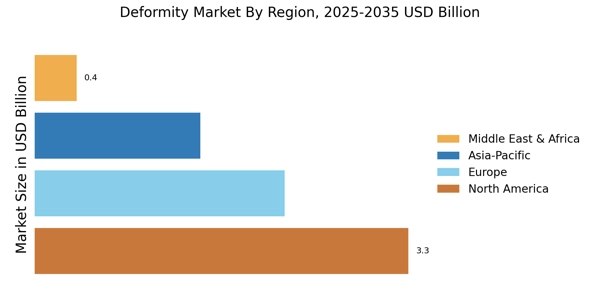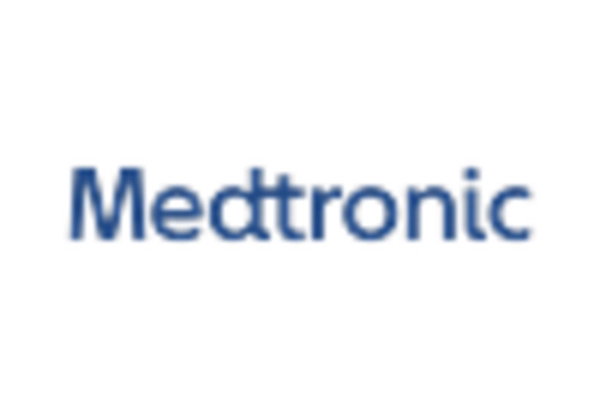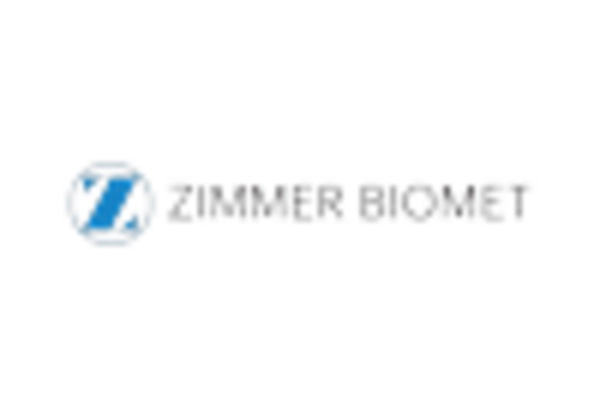Growing Geriatric Population
The Deformity Market is significantly influenced by the growing geriatric population, which is more susceptible to various deformities, including musculoskeletal disorders. As individuals age, the prevalence of conditions such as osteoporosis and arthritis increases, leading to a higher incidence of deformities. Recent statistics indicate that by 2030, the number of individuals aged 65 and older is projected to reach 1.5 billion, creating a substantial demand for deformity-related treatments. This demographic shift necessitates the development of specialized healthcare services and products tailored to the needs of older adults. Consequently, the Deformity Market is poised for growth as healthcare systems adapt to accommodate this aging population, focusing on preventive measures and effective treatment strategies.
Enhanced Rehabilitation Techniques
The Deformity Market is witnessing advancements in rehabilitation techniques that play a crucial role in the recovery process for individuals with deformities. Innovative therapies, including physical therapy, occupational therapy, and the use of assistive devices, are becoming more prevalent. These techniques not only aid in recovery but also improve the overall quality of life for patients. Recent studies indicate that effective rehabilitation can reduce the need for surgical interventions by up to 25%, highlighting its importance in the treatment continuum. As healthcare providers recognize the value of comprehensive rehabilitation programs, the Deformity Market is likely to expand, driven by the increasing emphasis on holistic patient care and long-term outcomes.
Rising Incidence of Congenital Deformities
The Deformity Market is also shaped by the rising incidence of congenital deformities, which are increasingly recognized as a significant public health concern. Factors such as genetic predispositions, environmental influences, and maternal health conditions contribute to the prevalence of these deformities. Recent data suggests that congenital deformities affect approximately 1 in 33 births, underscoring the need for early diagnosis and intervention. As awareness of these conditions grows, healthcare providers are more likely to invest in specialized treatments and technologies aimed at addressing congenital deformities. This trend is expected to drive the Deformity Market forward, as families seek comprehensive care options for affected individuals, thereby increasing the demand for innovative solutions.
Increased Investment in Research and Development
The Deformity Market is benefiting from increased investment in research and development, which is essential for driving innovation and improving treatment options. Pharmaceutical companies and medical device manufacturers are allocating substantial resources to explore new therapies and technologies aimed at addressing various deformities. Recent reports indicate that R&D spending in the orthopedic sector has risen by over 15% in the last few years, reflecting a commitment to advancing treatment methodologies. This influx of funding is likely to lead to the discovery of novel solutions, enhancing the effectiveness of existing treatments and potentially reducing the burden of deformities on healthcare systems. As a result, the Deformity Market is expected to thrive, fueled by ongoing advancements in medical science.
Technological Innovations in Surgical Procedures
The Deformity Market is experiencing a surge in technological innovations that enhance surgical procedures. Advanced imaging techniques, such as 3D printing and augmented reality, are revolutionizing preoperative planning and intraoperative navigation. These technologies allow for more precise corrections of deformities, leading to improved patient outcomes. According to recent data, the adoption of robotic-assisted surgeries has increased by approximately 30% over the past few years, indicating a shift towards minimally invasive techniques. This trend not only reduces recovery time but also minimizes complications, thereby attracting more patients to seek surgical interventions. As healthcare providers continue to invest in these technologies, the Deformity Market is likely to expand, driven by the demand for safer and more effective treatment options.


















Leave a Comment